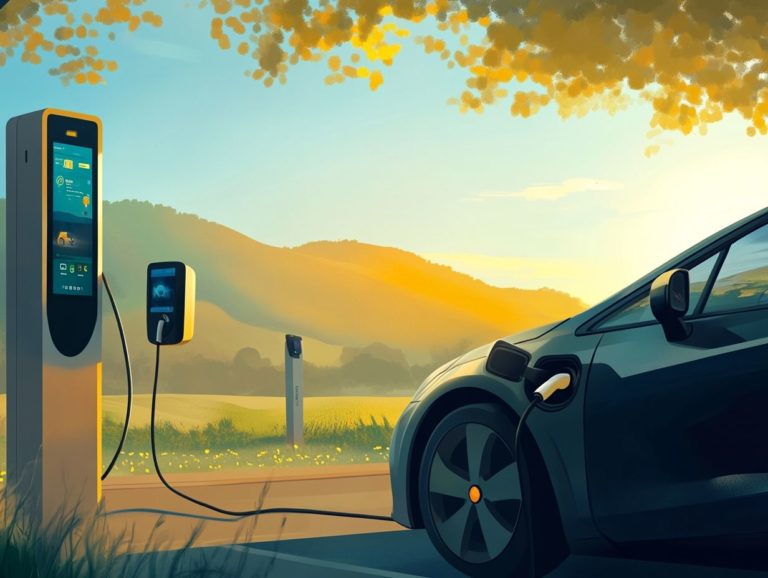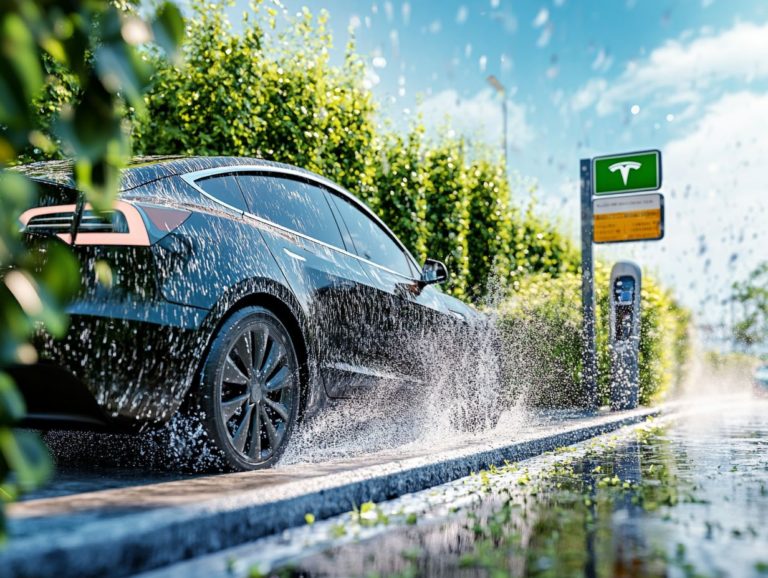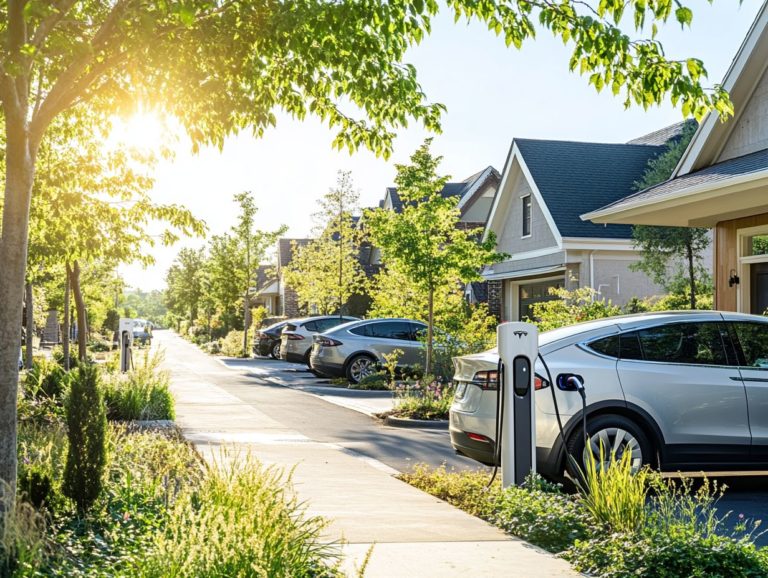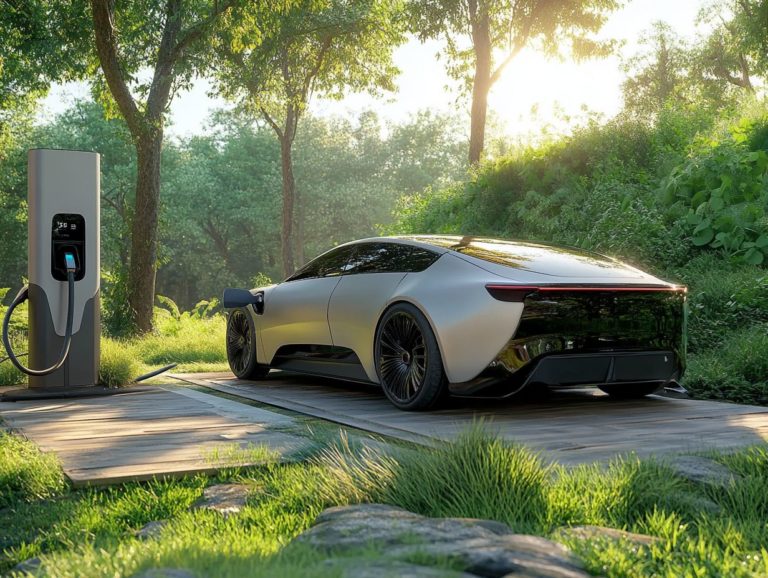How Do You Charge an Electric Vehicle?
As electric vehicles (EVs) become increasingly popular, it s crucial for you to grasp the various charging methods available for both new and prospective owners.
This article delves into everything from home charging stations to convenient on-the-go options, outlining the types, installation costs, and essential public charging etiquette you should be aware of.
It also addresses the factors that influence charging time, ensuring you are thoroughly prepared for your EV journey.
Whether you’re charging at home or on the move, get ready to elevate your EV experience with this essential guide!
Contents
- Key Takeaways:
- Charging an Electric Vehicle at Home
- Charging an Electric Vehicle on the Go
- Factors Affecting Charging Time
- Frequently Asked Questions
- Charging Your Electric Vehicle: What s the Best Way?
- Do I Need a Special Outlet to Charge My Electric Vehicle?
- How Long Does It Take to Charge an Electric Vehicle?
- Can I Charge My Electric Vehicle at Any Public Charging Station?
- What is a Fast Charging Station and How Does It Work?
- Do I Need to Charge My Electric Vehicle Every Day?
Key Takeaways:

- Charging an electric vehicle at home requires a special device designed specifically for charging electric vehicles, which can be either Level 1 or Level 2, and careful consideration of installation and cost.
- When charging an electric vehicle on the go, options include public charging stations. Make sure to follow etiquette, like not hogging the station for extended periods.
- The size of the battery and the charging rate affect the charging time of an electric vehicle, along with external factors like weather and temperature.
Overview of Charging Methods
Regarding EV charging, you have a variety of methods at your disposal, each with its own set of advantages and limitations. You’ll encounter Level 1, Level 2, and DC Fast Charging, along with public charging stations that make your daily commutes or long-distance travels much more convenient.
Selecting the right charging method is essential for optimizing your charging capacity and minimizing costs. It’s important to grasp the available options and the infrastructure that supports them.
Level 1 charging uses a standard 120-volt outlet, which is great for home use but can be quite slow, often requiring an overnight stay to fully charge your electric vehicle. To learn more about the costs associated with charging, check out how much it costs to charge an electric car.
In contrast, Level 2 charging operates on a 240-volt supply, significantly speeding up the process. You ll commonly find these at public charging stations, allowing you to recharge in just a few hours ideal for workplace charging or quick pit stops.
For those on the go, DC Fast Charging is your best friend. This quick charging method allows you to gain significant range in less than an hour perfect for road trips without the fuss.
Each charging method shapes your driving experience based on efficiency, accessibility, and cost implications. This plays a vital role in the expanding infrastructure of charging stations designed to meet the needs of electric vehicle users like you.
Charging an Electric Vehicle at Home
Charging your electric vehicle at home is convenient and cost-effective. You have options like Level 1 and Level 2 chargers, each with distinct installation costs and charging speeds.
These factors can significantly impact your energy savings and overall charging efficiency. Home charging not only meets your daily commuting needs but can also be sweetened with incentives like charging rebates, making it a compelling choice for many electric car owners.
Types of Home Charging Stations
There are two main types of home charging stations for electric vehicles: Level 1 charging, which operates from a standard 120-volt outlet, and Level 2 charging, requiring a 240-volt outlet. To better understand the charging process, you can learn about how long it takes to charge an EV. Each option offers distinct charging speeds and efficiencies tailored to different needs.
Level 1 chargers are perfect if you commute shorter distances and prefer to recharge overnight, typically adding about 3 to 5 miles of range per hour. This makes them an excellent option for urban dwellers or anyone who has a garage at home.
On the other hand, Level 2 chargers provide a much quicker charge, often delivering between 10 to 60 miles of range per hour. They are the go-to choice for households with multiple electric vehicles or those facing longer daily commutes.
By investing in Level 2 charging equipment, you can maximize your time and ensure your vehicle is always ready to hit the road. This transforms home charging into a seamless part of your routine, perfectly supporting your lifestyle.
Installation and Cost Considerations
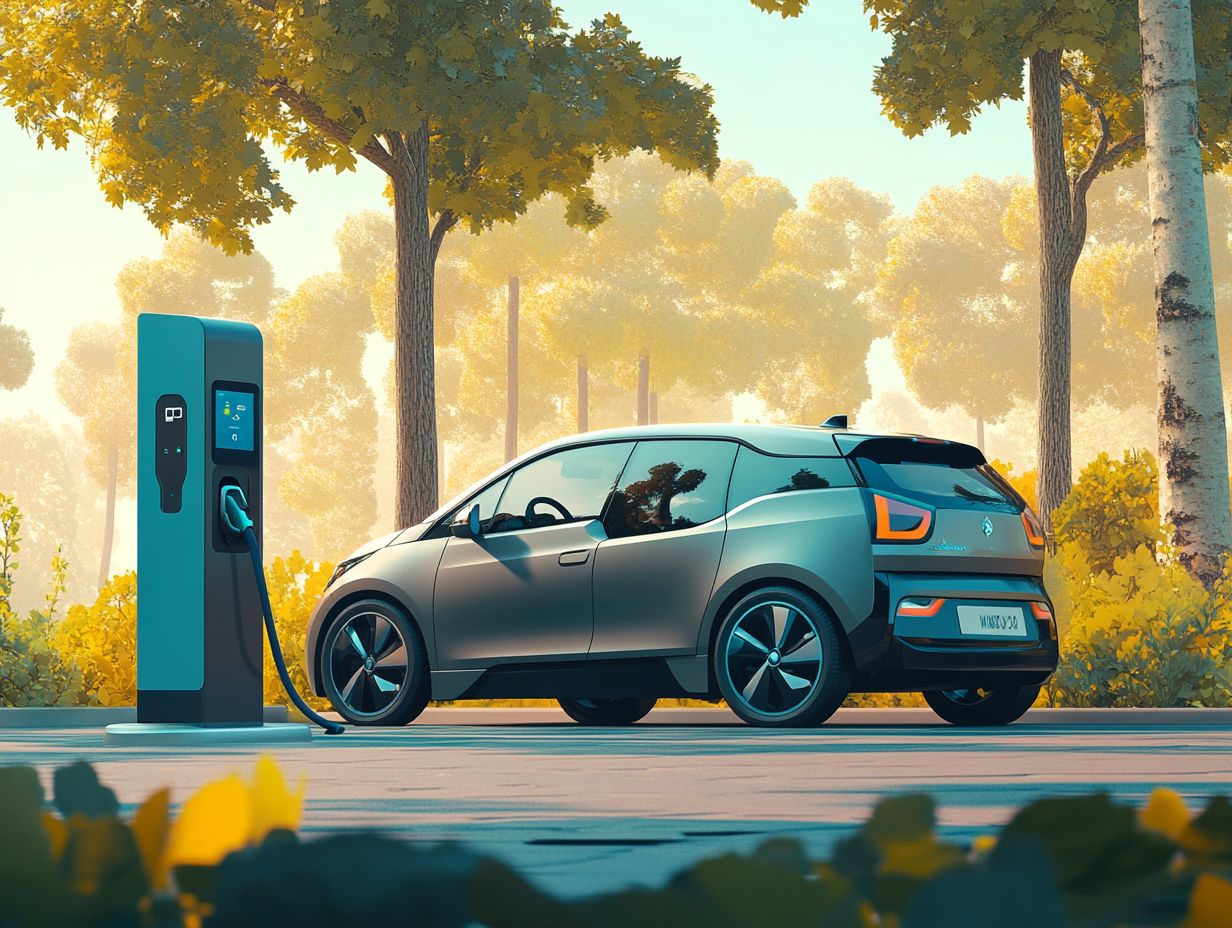
When you re thinking about installing home charging stations, several factors come into play. These include installation costs, available charging rebates, and potential energy savings.
Each of these elements significantly impacts the overall expense and feasibility of charging your electric vehicle at home. It s crucial to assess your home s electrical capacity and consult with your electric utility provider to ensure a smooth installation.
Be prepared for the possibility that certain upgrades may be necessary, especially if your current configuration can t support the additional load of a charging station. This might also involve securing permits, which could introduce another layer of expenses.
However, by researching local rebate programs, you might uncover substantial savings that can reduce your upfront costs while maximizing the long-term benefits of energy efficiency.
By gaining a comprehensive understanding of the factors influencing installation expenses, you ll be enabled to make informed decisions as a prospective electric vehicle owner.
Charging an Electric Vehicle on the Go
Charging your electric vehicle while on the move is easier than ever! Thanks to an expanding network of public charging stations, you have many options, including a fast way to charge your vehicle quickly while on the road.
By leveraging charging apps to find nearby stations and being mindful of proper charging etiquette, you can significantly enhance your experience as an EV driver navigating the public charging landscape.
Public Charging Options
Public charging options abound, featuring a variety of charging stations and networks tailored for electric vehicle drivers. DC Fast Charging stands out as a favored option for those in need of quick energy top-ups while on the go.
Understanding the range of public charging solutions at your disposal is essential for maximizing convenience and minimizing downtime during your travels.
Among these options, you ll often find Level 2 charging stations at shopping centers and workplaces, offering a slower yet steady charge perfect for longer stops. On the other hand, Tesla Superchargers provide an exclusive network designed specifically for Tesla owners, ensuring swift refueling on long road trips.
Your choice of charging station can greatly influence your experience, particularly in terms of wait times and cost efficiency. The interoperability of different networks plays a significant role in convenience, emphasizing the importance of selecting compatible charging stations for a seamless journey.
The availability of each network can impact your trip planning, making it vital for you to stay informed about the local charging infrastructure.
Charging Etiquette and Tips
Practicing good charging etiquette at public charging stations is vital for ensuring a positive experience for everyone in the electric vehicle community. Be mindful of how long you occupy a charging station, and allow others to access them promptly.
Utilizing charging apps can greatly assist in managing your time effectively and enhancing your overall convenience as a driver. By leveraging these digital tools, you can easily locate available stations, check real-time availability, and even reserve a slot if the app offers that feature.
It s wise to keep an eye on the clock and unplug once your vehicle is sufficiently charged not only does this show consideration for fellow drivers, but it also helps prevent congestion at busy stations. If you notice that your vehicle is taking longer to charge than expected, a quick check on the app can help you determine when the next driver might arrive, fostering a collaborative spirit within the electric vehicle community.
Factors Affecting Charging Time
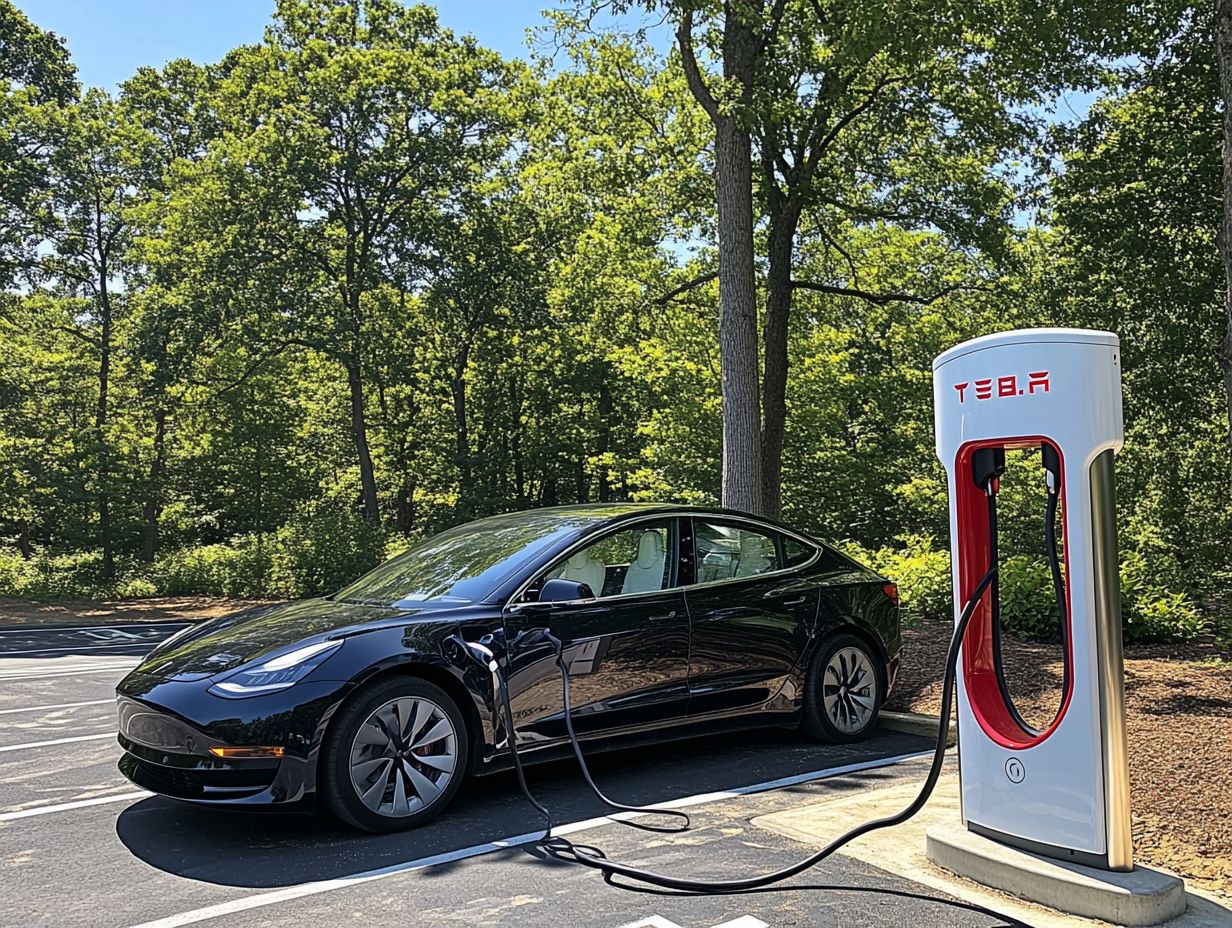
Several factors play a crucial role in determining the charging time of electric vehicles. These include the battery size, charging rate, and the power level of the charging equipment in use, along with the overall charging speed achievable under specific conditions.
Grasping these variables is essential for optimizing your charging sessions. This knowledge allows you to meet your driving range needs efficiently while minimizing downtime.
Battery Size and Charging Rate
The battery size of your electric vehicle significantly influences both the charging rate and overall charging speed. Larger batteries typically demand more time to charge compared to smaller ones, especially during home charging or at public stations. By understanding your vehicle’s battery specifications, you can manage your expectations and plan your charging needs effectively.
Larger batteries provide extended ranges. However, they often take longer to charge. Tailor your charging practices based on your specific EV model. For example, compact vehicles with smaller batteries usually enjoy faster charging rates, allowing for quick top-ups during short stops. If you’re driving a larger EV, consider using fast-charging networks during long trips to minimize downtime.
Embracing optimal charging practices like keeping your charging sessions between 20% and 80% can enhance battery life and provide a more efficient driving experience.
Weather and Temperature
Weather and temperature conditions can dramatically influence charging time and speed of electric vehicles. Extreme cold or heat impacts the efficiency of both the battery and the charging equipment, leading to longer charging sessions. Understanding how these environmental factors affect the charging process is crucial for any EV owner looking to optimize their charging experience.
In chilly climates, battery performance can decrease, resulting in reduced range and slower charging speeds. Conversely, high temperatures can cause batteries to overheat, hindering their ability to accept a full charge efficiently.
Consider these strategies to improve charging:
- Park in shaded areas on hot days.
- Use garage charging when temperatures dip.
Preconditioning the battery while your vehicle is still plugged in can enhance efficiency, ensuring it operates within the ideal temperature range.
By being mindful of these strategies, you can significantly improve your charging experience, regardless of what Mother Nature throws your way.
Frequently Asked Questions
Charging Your Electric Vehicle: What s the Best Way?

There are several ways to charge an electric vehicle. The most common methods include using a home charging station, public charging stations, and fast charging stations.
Do I Need a Special Outlet to Charge My Electric Vehicle?
Yes, you will need a dedicated 240-volt outlet to charge your electric vehicle at home. This outlet is similar to those used for large appliances like a clothes dryer or oven.
How Long Does It Take to Charge an Electric Vehicle?
The charging time can vary depending on the battery size and the charger type used. On average, it can take anywhere from 4 to 8 hours to fully charge an electric vehicle.
Can I Charge My Electric Vehicle at Any Public Charging Station?
Most public charging stations are compatible with all electric vehicles. However, it s a good idea to check the charging compatibility before using a public station.
What is a Fast Charging Station and How Does It Work?
A fast charging station, or a charger that works faster than regular chargers, can charge an electric vehicle in a fraction of the time. It uses higher voltage and current to quickly charge the battery.
Do I Need to Charge My Electric Vehicle Every Day?
The frequency of charging depends on your daily driving habits and the battery size. Most electric vehicle owners charge their vehicles every night to ensure they have a full charge for the next day.

